情态动词have to 和can 的用法
- 格式:doc
- 大小:13.00 KB
- 文档页数:1
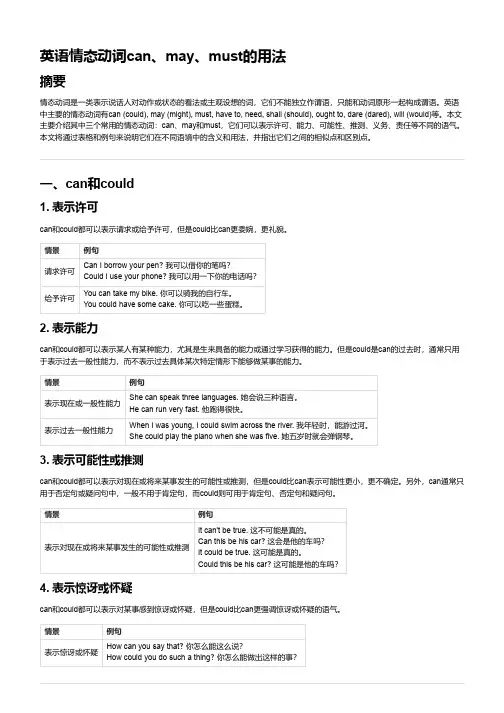
英语情态动词can、may、must的用法摘要情态动词是一类表示说话人对动作或状态的看法或主观设想的词,它们不能独立作谓语,只能和动词原形一起构成谓语。
英语中主要的情态动词有can (could), may (might), must, have to, need, shall (should), ought to, dare (dared), will (would)等。
本文主要介绍其中三个常用的情态动词:can、may和must,它们可以表示许可、能力、可能性、推测、义务、责任等不同的语气。
本文将通过表格和例句来说明它们在不同语境中的含义和用法,并指出它们之间的相似点和区别点。
一、can和could1. 表示许可can和could都可以表示请求或给予许可,但是could比can更委婉,更礼貌。
情景例句请求许可Can I borrow your pen? 我可以借你的笔吗?Could I use your phone? 我可以用一下你的电话吗?给予许可You can take my bike. 你可以骑我的自行车。
You could have some cake. 你可以吃一些蛋糕。
2. 表示能力can和could都可以表示某人有某种能力,尤其是生来具备的能力或通过学习获得的能力。
但是could是can的过去时,通常只用于表示过去一般性能力,而不表示过去具体某次特定情形下能够做某事的能力。
情景例句表示现在或一般性能力She can speak three languages. 她会说三种语言。
He can run very fast. 他跑得很快。
表示过去一般性能力When I was young, I could swim across the river. 我年轻时,能游过河。
She could play the piano when she was five. 她五岁时就会弹钢琴。
3. 表示可能性或推测can和could都可以表示对现在或将来某事发生的可能性或推测,但是could比can表示可能性更小,更不确定。
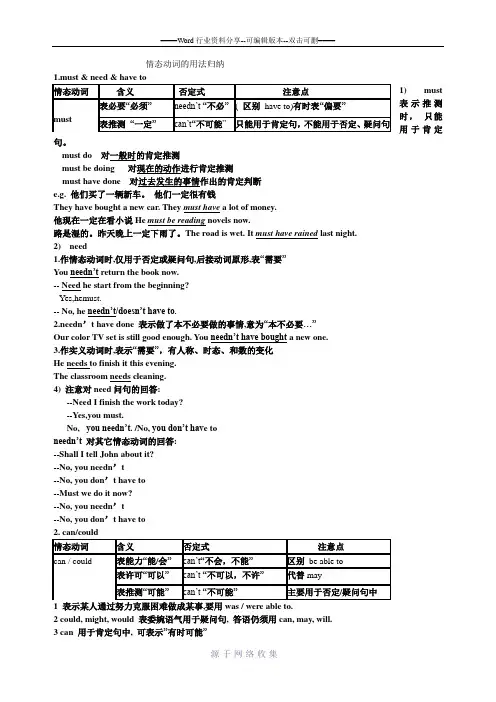
情态动词的用法归纳1) must 表示推测时, 只能用于肯定句。
must do 对一般时的肯定推测must be doing 对现在的动作进行肯定推测must have done 对过去发生的事情作出的肯定判断e.g. 他们买了一辆新车。
他们一定很有钱They have bought a new car. They must have a lot of money.他现在一定在看小说He must be reading novels now.路是湿的。
昨天晚上一定下雨了。
The road is wet. It must have rained last night.2) need1.作情态动词时,仅用于否定或疑问句,后接动词原形,表“需要”You needn’t return the book now.-- Need he start from the beginning?--Yes,hemust. -- No, he needn’t/doesn’t have to.2.needn ’t have done 表示做了本不必要做的事情,意为“本不必要…”Our color TV set is still good enough. You needn’t have bought a new one.3.作实义动词时,表示“需要”,有人称、时态、和数的变化He needs to finish it this evening.The classroom needs cleaning.4) 注意对need 问句的回答:--Need I finish the work today?--Yes,you must.No,you needn’t . /No, you don’t hav e toneedn’t 对其它情态动词的回答:--Shall I tell John about it?--No, you needn ’t--No, you don ’t have to--Must we do it now?--No, you needn ’t--No, you don ’t have to1 表示某人通过努力克服困难做成某事,要用was / were able to.2 could, might, would 表委婉语气用于疑问句, 答语仍须用can, may, will.3 can 用于肯定句中, 可表示”有时可能”4. can/could have done “本可以,本可能做某事” 用于肯定句中,表示对过去发生的事情做出的判断。
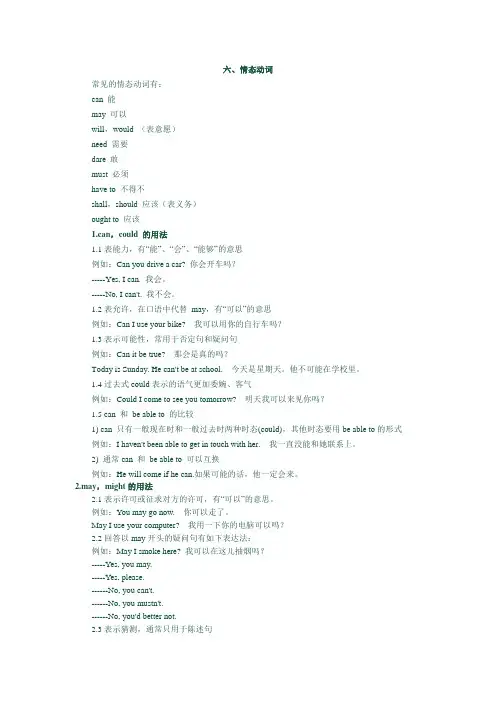
六、情态动词常见的情态动词有:can 能may 可以will,would (表意愿)need 需要dare 敢must 必须have to 不得不shall,should 应该(表义务)ought to 应该1.can,could 的用法1.1表能力,有“能”、“会”、“能够”的意思例如:Can you drive a car? 你会开车吗?-----Yes, I can. 我会。
-----No, I can't. 我不会。
1.2表允许,在口语中代替may,有“可以”的意思例如:Can I use your bike?我可以用你的自行车吗?1.3表示可能性,常用于否定句和疑问句例如:Can it be true?那会是真的吗?Today is Sunday. He can't be at school.今天是星期天。
他不可能在学校里。
1.4过去式could表示的语气更加委婉、客气例如:Could I come to see you tomorrow?明天我可以来见你吗?1.5 can 和be able to 的比较1) can 只有一般现在时和一般过去时两种时态(could),其他时态要用be able to的形式例如:I haven't been able to get in touch with her.我一直没能和她联系上。
2) 通常can 和be able to 可以互换例如:He will come if he can.如果可能的话,他一定会来。
2.may,might的用法2.1表示许可或征求对方的许可,有“可以”的意思。
例如:Y ou may go now.你可以走了。
May I use your computer?我用一下你的电脑可以吗?2.2回答以may开头的疑问句有如下表达法:例如:May I s moke here? 我可以在这儿抽烟吗?-----Y es, you may.-----Y es, please.------No, you can't.------No, you mustn't.------No, you'd better not.2.3表示猜测,通常只用于陈述句例如:Y ou may be right.你可能是对的。
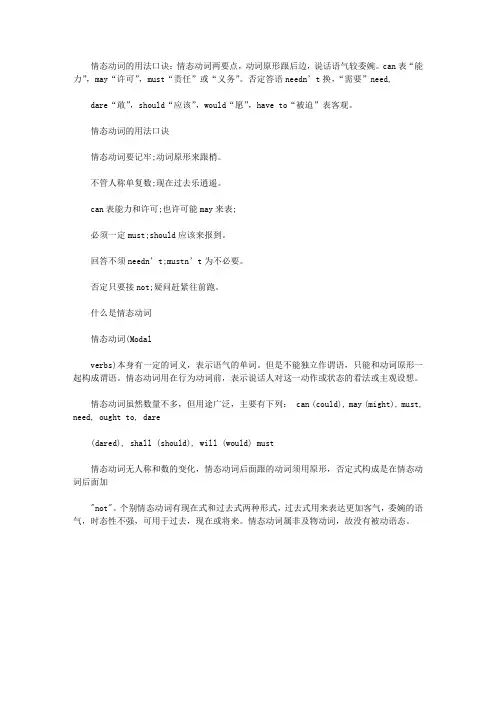
情态动词的用法口诀:情态动词两要点,动词原形跟后边,说话语气较委婉。
can表“能力”,may“许可”,must“责任”或“义务”。
否定答语needn’t换,“需要”need,
dare“敢”,should“应该”,would“愿”,have to“被迫”表客观。
情态动词的用法口诀
情态动词要记牢;动词原形来跟梢。
不管人称单复数;现在过去乐逍遥。
can表能力和许可;也许可能may来表;
必须一定must;should应该来报到。
回答不须needn’t;mustn’t为不必要。
否定只要接not;疑问赶紧往前跑。
什么是情态动词
情态动词(Modal
verbs)本身有一定的词义,表示语气的单词。
但是不能独立作谓语,只能和动词原形一起构成谓语。
情态动词用在行为动词前,表示说话人对这一动作或状态的看法或主观设想。
情态动词虽然数量不多,但用途广泛,主要有下列: can (could), may (might), must, need, ought to, dare
(dared), shall (should), will (would) must
情态动词无人称和数的变化,情态动词后面跟的动词须用原形,否定式构成是在情态动词后面加
"not"。
个别情态动词有现在式和过去式两种形式,过去式用来表达更加客气,委婉的语气,时态性不强,可用于过去,现在或将来。
情态动词属非及物动词,故没有被动语态。
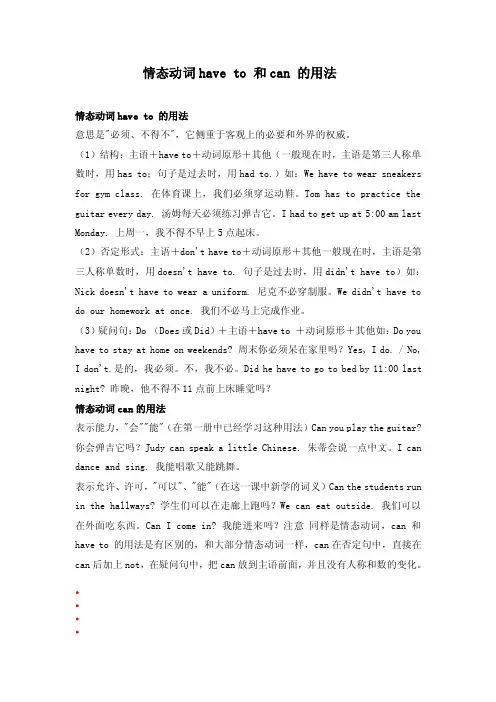
情态动词have to 和can 的用法情态动词have to 的用法意思是"必须、不得不",它侧重于客观上的必要和外界的权威。
(1)结构:主语+have to+动词原形+其他(一般现在时,主语是第三人称单数时,用has to;句子是过去时,用had to.)如:We have to wear sneakers for gym class. 在体育课上,我们必须穿运动鞋。
Tom has to practice the guitar every day. 汤姆每天必须练习弹吉它。
I had to get up at 5:00 am last Monday. 上周一,我不得不早上5点起床。
(2)否定形式:主语+don't have to+动词原形+其他一般现在时,主语是第三人称单数时,用doesn't have to. 句子是过去时,用didn't have to)如:Nick doesn't have to wear a uniform. 尼克不必穿制服。
We didn't have to do our homework at once. 我们不必马上完成作业。
(3)疑问句:Do (Does或Did)+主语+have to +动词原形+其他如:Do you have to stay at home on weekends? 周末你必须呆在家里吗?Yes, I do. / No, I don't.是的,我必须。
不,我不必。
Did he have to go to bed by 11:00 last night? 昨晚,他不得不11点前上床睡觉吗?情态动词can的用法表示能力,"会""能"(在第一册中已经学习这种用法)Can you play the guitar? 你会弹吉它吗?Judy can speak a little Chinese. 朱蒂会说一点中文。
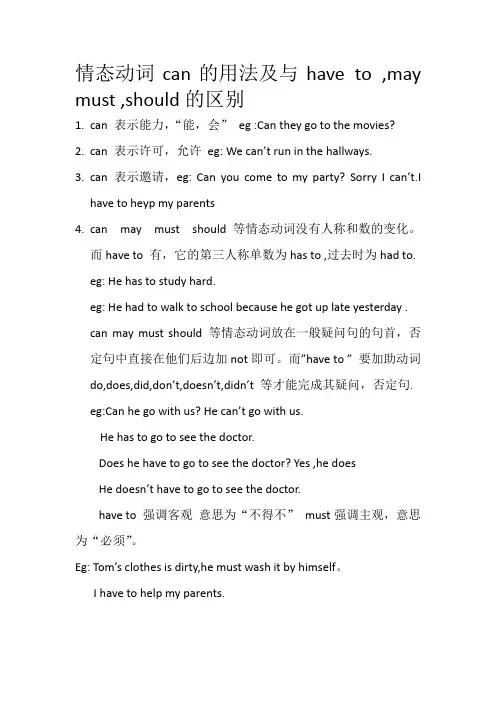
情态动词can的用法及与have to ,may must ,should的区别1.can 表示能力,“能,会”eg :Can they go to the movies?2.can 表示许可,允许eg: We can’t run in the hallways.3.can 表示邀请,eg: Can you come to my party? Sorry I can’t.Ihave to heyp my parents4.can may must should等情态动词没有人称和数的变化。
而have to 有,它的第三人称单数为has to ,过去时为had to.eg: He has to study hard.eg: He had to walk to school because he got up late yesterday .can may must should 等情态动词放在一般疑问句的句首,否定句中直接在他们后边加not即可。
而”have to ”要加助动词do,does,did,don’t,doesn’t,didn’t 等才能完成其疑问,否定句.eg:Can he go with us? He can’t go with us.He has to go to see the doctor.Does he have to go to see the doctor? Yes ,he doesHe doesn’t have to go to see the doctor.have to 强调客观意思为“不得不”must强调主观,意思为“必须”。
Eg: Tom’s clothes is dirty,he must wash it by himself。
I have to help my parents.。
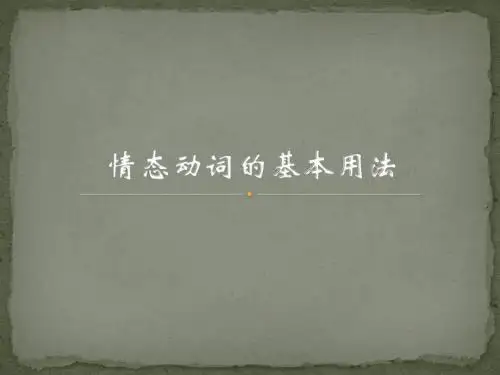
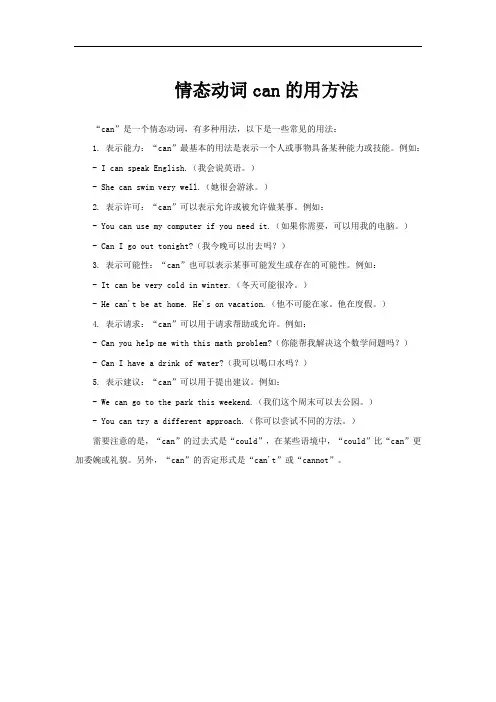
情态动词can的用方法“can”是一个情态动词,有多种用法,以下是一些常见的用法:1. 表示能力:“can”最基本的用法是表示一个人或事物具备某种能力或技能。
例如:- I can speak English.(我会说英语。
)- She can swim very well.(她很会游泳。
)2. 表示许可:“can”可以表示允许或被允许做某事。
例如:- You can use my computer if you need it.(如果你需要,可以用我的电脑。
)- Can I go out tonight?(我今晚可以出去吗?)3. 表示可能性:“can”也可以表示某事可能发生或存在的可能性。
例如:- It can be very cold in winter.(冬天可能很冷。
)- He can't be at home. He's on vacation.(他不可能在家。
他在度假。
)4. 表示请求:“can”可以用于请求帮助或允许。
例如:- Can you help me with this math problem?(你能帮我解决这个数学问题吗?)- Can I have a drink of water?(我可以喝口水吗?)5. 表示建议:“can”可以用于提出建议。
例如:- We can go to the park this weekend.(我们这个周末可以去公园。
)- You can try a different approach.(你可以尝试不同的方法。
)需要注意的是,“can”的过去式是“could”,在某些语境中,“could”比“can”更加委婉或礼貌。
另外,“can”的否定形式是“can't”或“cannot”。
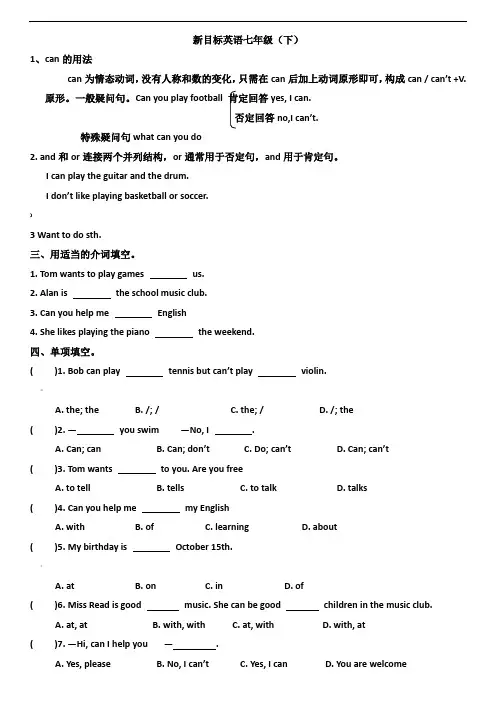
新目标英语七年级(下)1、can的用法can为情态动词,没有人称和数的变化,只需在can后加上动词原形即可,构成can / can’t +V.原形。
一般疑问句。
Can you play football 肯定回答yes, I can.否定回答no,I can’t.特殊疑问句what can you do2. and和or连接两个并列结构,or通常用于否定句,and用于肯定句。
I can play the guitar and the drum.I don’t like playing basketball or soccer.)3 Want to do sth.三、用适当的介词填空。
1. Tom wants to play games us.2. Alan is the school music club.3. Can you help me English4. She likes playing the piano the weekend.四、单项填空。
( )1. Bob can play tennis but can’t play violin.~A. the; theB. /; /C. the; /D. /; the( )2. —you swim —No, I .A. Can; canB. Can; don’tC. Do; can’tD. Can; can’t( )3. Tom wants to you. Are you freeA. to tellB. tellsC. to talkD. talks( )4. Can you help me my EnglishA. withB. ofC. learningD. about( )5. My birthday is October 15th.:A. atB. onC. inD. of( )6. Miss Read is good music. She can be good children in the music club.A. at, atB. with, withC. at, withD. with, at( )7. —Hi, can I help you —.A. Yes, pleaseB. No, I can’tC. Yes, I canD. You are welcome( )9. Can he it in EnglishA. speakB. speaksC. sayD. talk( )10. Are you good at basketball。
![情态动词can,may,must的用法[1].](https://uimg.taocdn.com/bcf311f09e3143323968938d.webp)
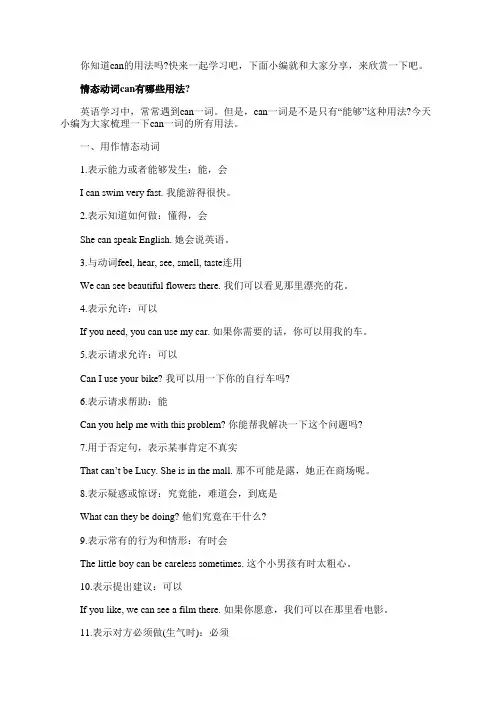
你知道can的用法吗?快来一起学习吧,下面小编就和大家分享,来欣赏一下吧。
情态动词can有哪些用法?英语学习中,常常遇到can一词。
但是,can一词是不是只有“能够”这种用法?今天小编为大家梳理一下can一词的所有用法。
一、用作情态动词1.表示能力或者能够发生:能,会I can swim very fast. 我能游得很快。
2.表示知道如何做:懂得,会She can speak English. 她会说英语。
3.与动词feel, hear, see, smell, taste连用We can see beautiful flowers there. 我们可以看见那里漂亮的花。
4.表示允许:可以If you need, you can use my car. 如果你需要的话,你可以用我的车。
5.表示请求允许:可以Can I use your bike? 我可以用一下你的自行车吗?6.表示请求帮助:能Can you help me with this problem? 你能帮我解决一下这个问题吗?7.用于否定句,表示某事肯定不真实That can’t be Lucy. She is in the mall. 那不可能是露,她正在商场呢。
8.表示疑惑或惊讶:究竟能,难道会,到底是What can they be doing? 他们究竟在干什么?9.表示常有的行为和情形:有时会The little boy can be careless sometimes. 这个小男孩有时太粗心。
10.表示提出建议:可以If you like, we can see a film there. 如果你愿意,我们可以在那里看电影。
11.表示对方必须做(生气时):必须You can shut up or get out. 你给我闭嘴,要不然就滚出去!二、用作名词1.金属罐: a can of beans 豆罐头2.一听:a can of Coke 一听可口可乐3.装运液体)金属容器、塑料容器:an oil can 油罐4.牢房,厕所: the can(只有单数形式)三、用作动词1.把(食品)装罐保存2.让…卷铺盖走人,炒…的鱿鱼在日常学习中,很少遇到can用作名词和动词用法,但我们要熟知其意义及其用法,做到熟练掌握,灵活运用!情态动词can的用法,绝对没你想象得那么简单!在英语学习中,情态动词是一个很重要的语法点,其中情态动词can的用法比较常见。
Have to的用法都有哪些ave to 是一个比较特殊的情态习语,虽然也具有情态动词的功能,但却与其他的情态动词不同。
它有人称、数和时态的变化,其否定式和疑问式的构成方式也与情态动词不一样。
同学们在使用have to 时必须弄清它的真面目,否则容易出错。
Have to的用法有哪些呢?本文是店铺整理Have to的用法的资料,仅供参考。
Have to的用法have to表示客观需要做的事情,意思是“必须”、“不得不”.后跟动词原形,有人称、时态和数的变化,与情态动词 must 近义.一、 have to 的陈述句形式A、肯定式:have to + 动词原形1、 I have to tidy my room.我得整理房间.2、 She has to help with the washing.她得帮忙洗衣服.B、否定式:don't (doesn't) + haveto + 动词原形1、You don't have to go if you don't want to.如果你不想去,你就不必去.2、He doesn't have to stay at home all day.他不必整天呆在家里.二、have to 的一般疑问句形式及简略答语have to的一般疑问形式必须借助助动词 do 或 does:1、 Do you have to look after your sister?你得照看你妹妹么?Yes,I do./ No,I don't.是的,我得照看./不,我不必照看.2、 Does Jim have to do his homework?吉姆必须做家庭作业么?Yes,he does./ No,he doesn't.是,他必须做./不,他不必做.三、haveto 的特殊疑问句形式1、 What do you have to do on Sundays?在星期天你得干什么?2、 Why does she have to move to Paris?她为什么得迁往巴黎?3、 Where do they have to work?他们必须在哪里工作?四、haveto 可用于各种时态A、一般现在时:I have to visit Mr Wang tomorrow.明天我得去拜访王先生.B、一般过去时:That night we had to walk home because there was no bus.那天晚上我们不得不步行回家,因为没有公共汽车.C、一般将来时:We'll have to ask Zhang Ming instead.我们得请张明代替.D、与may 连用:I think he may have to help his Dad in the garden.我想他可能得在花园里帮他爸爸干活.五、have to 与 must 的用法区别A、 have to 比较强调客观需要,而 must 着重说明主观看法.1、 My mother is ill.I have to look after her at home.妈妈病了,我得在家照看她.2、 You must finish your homework first.你必须先完成作业.B、 have to 有时态和人称变化,而 must 则没有.1、 Mary has to water the trees.玛莉得浇树.2、 He must bring a picnic tomorrow.他明天得带野餐.C、must 有“推测”之意,而 have to 则没有.He must be in the classroom.他一定在教室里.have to 的用法一、have to 与其他情态动词一样也是后接动词原形,表示外界的强制作用,强调被迫性。
情态动词 have to 用法小结作者:杨秀祥情态动词have to (口语中说成have got to)表示客观需要做的事情,意为“必须;不得不”。
它和其他情态动词相比较,有很多不同之处,现在就将其用法要点小结如下:一、have to同情态动词must 的区别。
have to 和must 都有“必须”的意思。
但是 have to侧重于强调客观条件需要做的事情。
而must 侧重于表示说话人的主观看法,认为有义务,有必要去做某事。
例如:1. I have to clean my room first.2. You must be here before eight.二、have to 有人称和数的变化,其他情态动词没有。
例如:1. Mr Green has to work on the farm all day.2. I / He can swim in the river.三、have to有多种时态的变化,而can, may等只有过去式等形式。
例如:1. We will have to ask Li Lei instead.2. I thought I could smell something burning.四、have to不能直接用来否定或提问,需要助动词do / did / does等帮助。
而其他的情态动词一般都可以直接进行否定和提问。
例如:1. What does she have to do?2. You don't have to help her with her homework.3. May I come in?五、have to可以被may 等情态动词修饰,其他动词之间不能互相修饰。
例如:I think you may have to finish the work today.。
【语法专项突破】:情态动词can与have to 的用法你会说英语吗你必须学习英语。
“会”和“必须”在英语中是情态动词,它们的用法可是要你认真学习的呀!先观察下面的句子:1.—Can you speak French你会说法语吗表示能力—No,I can't.不,我不会。
2.You can take the car,if you want.表示许可如果你想的话,你可以坐汽车。
3.—Can you give me some advice表示请求你能给我一些建议吗—Of course.当然可以了。
4.You can't play in the street.表示禁止你们不准在街道上玩。
5.That can't be Mr. is not here at the moment.表否定推测那肯定不是刘先生。
他此刻不在这里。
6.It's have_to go now.天晚了。
我不得不走了。
7.—Does he have_to get up early in the morning他必须早上早起床吗—Yes,he does.是的。
8.She didn't_have_to walk home yesterday.昨天她不必走着回家。
【例1】—Li Hai ,______ you speak Chinese—Yes ,only a little.A .mustB .needC .have toD .can【例2】—Will you stay for lunch—Sorry ,I brother is coming to see me.A .mustn'tB .can'tC .needn'tD .won't【例3】—I can't give up smoking ,doctor.—For your health ,I'm afraid you______.A .mayB .canC .have toD .could。
情态动词must的用法must表示“必须”。
例句:(1) Don’t arrive late for class. We must be on time.上课别迟到,我们必须准时。
(2) You must read a book before you watch TV.看电视前必须先读书。
情态动词can表“许可”的用法can表示许可,意为“可以”。
can的否定形式为can not,可缩写为can’t。
例句:(1) You can play basketball on weekends.你可以在周末打篮球。
(2) We can’t run in the hallways.我们不可以在走廊里跑。
一般疑问句:Can+主语+动词原形+其他?肯定回答:Yes, 主语+can.否定回答:No,主语+can’t.例句:—Can we wear a hat in class?—Yes, we can./No, we can’t.—上课可以戴帽子吗?—是的,可以。
/不,不可以。
情态动词have to的用法have to表示“不得不;必须”。
例句:(1) We have to be quiet in the library.在图书馆内,我们必须安静。
(2) She has to do her homework first when she gets home.她回家后必须先做作业。
一般疑问句:Do/Does+主语+have to+其他?肯定回答:Yes, 主语+do/does.否定回答:No,主语+don’t/doesn’t.例句:—Does he have to wear a uniform at school?—Yes, he does./No, he doesn’t.I. 单项选择。
( ) 1. —You ________ borrow two books at a time from the library.—Thanks.A. canB. can’tC. mustD. have to【难度】:★★★【解析】:句意:——你________一次从图书馆借两本书。
情态动词have to 和can 的用法
情态动词have to 的用法
意思是"必须、不得不",它侧重于客观上的必要和外界的权威。
(1)结构:主语+have to+动词原形+其他(一般现在时,主语是第三人称单数时,用has to;句子是过去时,用had to.)如:We have to wear sneakers for gym class. 在体育课上,我们必须穿运动鞋。
Tom has to practice the guitar every day. 汤姆每天必须练习弹吉它。
I had to get up at 5:00 am last Monday. 上周一,我不得不早上5点起床。
(2)否定形式:主语+don't have to+动词原形+其他一般现在时,主语是第三人称单数时,用doesn't have to. 句子是过去时,用didn't have to)如:Nick doesn't have to wear a uniform. 尼克不必穿制服。
We didn't have to do our homework at once. 我们不必马上完成作业。
(3)疑问句:Do (Does或Did)+主语+have to +动词原形+其他如:Do you have to stay at home on weekends? 周末你必须呆在家里吗?Yes, I do. / No, I don't.是的,我必须。
不,我不必。
Did he have to go to bed by 11:00 last night? 昨晚,他不得不11点前上床睡觉吗?
情态动词can的用法
表示能力,"会""能"(在第一册中已经学习这种用法)Can you play the guitar? 你会弹吉它吗?Judy can speak a little Chinese. 朱蒂会说一点中文。
I can dance and sing. 我能唱歌又能跳舞。
表示允许、许可,"可以"、"能"(在这一课中新学的词义)Can the students run in the hallways? 学生们可以在走廊上跑吗?We can eat outside. 我们可以在外面吃东西。
Can I come in? 我能进来吗?注意同样是情态动词,can 和have to 的用法是有区别的,和大部分情态动词一样,can在否定句中,直接在can后加上not,在疑问句中,把can放到主语前面,并且没有人称和数的变化。